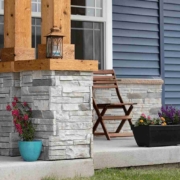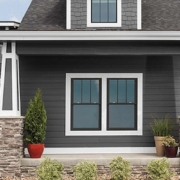When it comes to home improvement, the choice of windows plays a pivotal role. Not only do they serve as a gateway for natural light, but they also contribute significantly to the energy efficiency and overall aesthetics of your home. And when it comes to vinyl replacement windows, Vinylmax stands out as a top choice for homeowners.
But why Vinylmax, you may ask? Well, Vinylmax Windows offer a unique blend of quality, durability, and style. Produced by a reputable company, Vinylmax Windows come with the assurance of energy efficiency, promising not just an upgraded look for your home, but also considerable savings on your energy bills.
Key Takeaways
- Vinylmax Windows offer reliable, energy-efficient and durable options for custom home window replacement.
- Professional installation, warranty and financing options are available through CoMo Premium Exteriors to ensure a seamless experience with guaranteed peace of mind.
- Vinylmax windows can reduce energy consumption while increasing the value of your home.
Vinylmax Windows: A Comprehensive Overview

Vinylmax Windows
Vinylmax, a company held in high regard for its reliability, has carved a niche in the market with its vinyl replacement windows. These custom-made windows not only offer an aesthetic upgrade for your home, but they also come with features that enhance energy efficiency and durability.
From heavy-duty die-cast locks to BetterVue improved visibility screen mesh, Vinylmax windows, including casement windows, are crafted with meticulous attention to detail. Not to mention, Vinylmax’s commitment to preventing greenhouse gas emissions is evident in their energy-efficient picture window options, which have earned them the title of the “Most Efficient of ENERGY STAR 2020”.
Energy Efficiency
With their commitment to energy efficiency, Vinylmax Windows takes the stage with features designed to reduce your home’s energy consumption. One of the key elements that contribute to this efficiency is the use of argon gas as an insulating agent. With its low thermal conductivity and high density, argon gas in Vinylmax windows helps keep your home cozy and your energy bills low.
Adding to the energy efficiency are the SolarZone Low-E glass coatings and the Warm-Edge Spacer System. The former blocks heat gain from the sun’s reflected rays in summer while allowing warmth from shorter solar rays to enter the house during winter, and the latter helps to reduce heat loss and condensation on winter glass, thus increasing the energy efficiency of the window. Indeed, Vinylmax’s robust energy-saving features are a testament to the company’s commitment to quality and efficiency.
Durability
The durability of Vinylmax Windows is another factor that sets them apart. Constructed with strong and resilient vinyl material, these windows are resistant to:
- abrasion
- moisture
- rust
- corrosion
The windows feature a sealed, one-piece design with Intercept spacers that are stronger and more effective in preserving insulating gas.
Their frames and sashes are reinforced with four-point fusion welding, ensuring strength and stability. This technique ensures that the corners will never pull apart, contributing to enhanced strength and stability of the windows. Backed by a limited lifetime warranty on vinyl and hardware, Vinylmax Windows are built to withstand the test of time.
Style Options
While durability and energy efficiency are crucial, the aesthetic appeal of windows cannot be overlooked. Thankfully, Vinylmax Windows excel in this department as well, offering a variety of window styles and product lines to choose from.
Whether your home is traditional, contemporary, or modern in design, Vinylmax Windows can be tailored to elevate your home’s aesthetics. With features like:
- Bronze and tan hardware options
- Dual and triple-glazed glass
- Vertical or horizontal options
- A variety of grid patterns
Vinylmax Windows in 2022 can be the perfect fit for any home’s architectural style.
Comparing Vinylmax Window Series

Vinylmax Window Series Comparison
While Vinylmax as a brand is a top choice for vinyl replacement windows, the company offers a range of window series to cater to different needs and preferences. Whether it’s the Newton, Edison, Prestige, or Hyde Park series, each offers unique features and benefits, making the choice dependent on your specific requirements and budget.
While the source suggests the Newton, Edison, and Prestige series for their excellent features and value for money, it advises against the lower-end series.
We shall analyze these series to comprehend their individual features and advantages, as well as their access-related aspects, taking into account their unique characteristics and the impact of ads. One important aspect to consider is the use of http in their online presence, and the possible need for permission to access certain content.
Newton Series
The Newton Series, a premium line of vinyl replacement windows from Vinylmax, offers the following features:
- Slope sill
- Thermal insulation
- Cove interior sash
- Shadow-grooved sash welds
- Extruded half screen
These windows are priced at $750 to $950 installed, and they set a high bar for quality.
With its multi-chambered vinyl for enhanced strength and thermal efficiency, and solid Timberstrand laminated wood mullion construction for increased durability, the Newton Series offers an impressive blend of quality and performance.
What’s more, the slope sill provides various benefits such as improved drainage and prevention of air infiltration, securing the sashes and guiding water away from the property.
Edison Series
The Edison Series, on the other hand, offers an affordable option without compromising on quality. Priced between $700 to $900 when installed, the Edison series comes equipped with a fusion-welded frame and triple weatherstripping.
The four-point fusion welding technique used ensures that the frames and sashes are strong, square, and durable, contributing to the overall durability of the windows. What’s more, the triple weatherstripping provides improved insulation and better energy efficiency by obstructing drafts and air leakage, thus keeping a stable indoor temperature.
Prestige Series
If you’re looking for high performance at a reasonable price, the Prestige Series is worth considering. Renowned for its performance and aesthetic appeal, the Prestige Series offers maximum energy efficiency with its high-performance glass packages.
The Prestige Series windows feature:
- A robust gear and aggressive tooth design for easy opening
- A sash that opens 90 degrees for convenient cleaning of both interior and exterior glass surfaces
- A color-synchronized, weather-resistant PVC exterior that requires zero maintenance and is resistant to scratches and dents.
Hyde Park Series
The Hyde Park Series is a reliable, mid-range window option featuring a sturdy frame and a lifetime warranty, all at an affordable price of $550 installed. The windows in this series boast a one-piece, tin-plated U-channel design that serves as an effective thermal barrier, multi-chambered vinyl construction for strength and thermal efficiency, and a cove molded sash detail for a classic wood window look.
With their modern fusion-welded beveled frame, the Hyde Park Series offers a great blend of durability and style at a competitive price point. Moreover, the windows come with a lifetime warranty that includes coverage for accidental glass breakage, offering peace of mind for homeowners.
CoMo Premium Exteriors and Vinylmax Windows

CoMo Premium Exteriors and Vinylmax Windows Partnership
CoMo Premium Exteriors, a Missouri-based exterior remodeling company, partners with Vinylmax Windows to provide homeowners with professional installation, warranty, and financing options. As an industry-certified installer, CoMo Premium Exteriors ensures that Vinylmax Windows are installed to the highest standards, providing a seamless experience for homeowners.
Besides their professional installation services, CoMo Premium Exteriors provides a 5-Year Workmanship Warranty, 1-Year Clean-Up Guarantee, and Manufacturer’s Warranty, guaranteeing homeowners peace of mind with their new windows. The company also offers easy-to-manage financing options, simplifying the financial aspect of window replacement projects for homeowners.
Professional Installation
CoMo Premium Exteriors prides itself on its professional project management, ensuring that every installation is carried out to the highest standards. Their certified installers have the knowledge and expertise to ensure a seamless and efficient installation process.
The company guarantees customer satisfaction during the window installation process by providing free estimates for all work and delivering expert installation service from their professional team. Their focus on customer satisfaction and quality workmanship ensures that the process of installing Vinylmax Windows is smooth and hassle-free.
Warranty and Financing Options
Apart from its professional installation services, CoMo Premium Exteriors provides strong warranty options. The company provides a 5-Year Workmanship Warranty and a 1-Year Clean-Up Guarantee, covering repairs for a span of 5 years and a clean-up warranty for repairs for a year.
Furthermore, CoMo Premium Exteriors offers a Manufacturer’s Warranty, covering the products used in replacement projects such as roofing, siding, windows, gutters, decks, soffit, and fascia.
For homeowners looking to finance their window replacement project, the company provides competitive financing options, making it easier to afford quality vinyl replacement windows like those from Vinylmax.
Upgrading Your Home with Vinylmax Windows

Energy Savings with Vinylmax Windows
Upgrading your home with Vinylmax Windows can result in substantial energy savings and an enhanced home value. Being recognized as the Most Efficient of ENERGY STAR 2020, Vinylmax windows are designed to reduce energy consumption in homes, helping homeowners save on their energy bills.
Moreover, upgrading to Vinylmax windows can result in an estimated return of $6,860 for every $10,000 invested in window replacement, making Vinylmax windows a worthy investment for homeowners keen on boosting their home’s value while also cutting down on energy usage.
Energy Savings
Vinylmax Windows are designed with energy efficiency at the forefront. Their advanced insulation features, such as multiple glass panes and low-emissivity coatings, help to reduce heat transfer and improve thermal performance.
While the exact amount of savings will be dependent on factors such as the size of the home and current energy usage, installing ENERGY STAR qualified windows like Vinylmax can result in lower energy bills and cost savings over time.
Indeed, opting for Vinylmax windows can contribute to a greener and more energy-saving lifestyle for your home.
Enhanced Home Value
To install Vinylmax Windows can significantly enhance your home’s value. Their durability, energy efficiency, and aesthetic appeal make them a great investment for homeowners.
Studies suggest that replacing vinyl windows adds an average value of $13,766 to a home, which is roughly 69% of the project cost. Moreover, Vinylmax products, certified as the Most Efficient of ENERGY STAR 2021, offer superior energy performance, further enhancing their appeal.
Summary
In conclusion, Vinylmax Windows offer a unique blend of quality, durability, and style, making them a top choice for vinyl replacement windows. Whether it’s their energy efficiency, diverse style options, or the variety of series to choose from, Vinylmax Windows cater to the diverse needs and preferences of homeowners.
Moreover, with professional installation, robust warranty options, and financing options provided by CoMo Premium Exteriors, upgrading your home with Vinylmax Windows has never been easier. So, if you’re considering a window replacement, Vinylmax Windows and CoMo Premium Exteriors make an excellent team that you can rely on for quality, sustainability, and value for your investment.
Frequently Asked Questions
Are vinyl windows any good?
Vinyl windows have a lifespan of over 20 years, help save energy costs, and require no maintenance – making them an excellent choice for many homeowners.
How long do vinyl windows typically last?
Vinyl windows typically last between 20-40 years, depending on the climate and conditions.
Are vinyl windows considered cheap?
Vinyl windows are one of the most cost-effective window types, made of durable polyvinyl chloride (PVC). Their lifespan can range from a few years to a lifetime, depending on their construction, making them an affordable window option.
What are the key features of Vinylmax Windows?
Vinylmax Windows offer custom-made bay and bow windows, heavy-duty die-cast locks, premium vinyl window performance with IdeaSeal™ triple protection, and BetterVue improved visibility screen mesh. They also feature casement windows in their product line.
How does Vinylmax ensure energy efficiency in its windows?
Vinylmax Windows maximize energy efficiency through features such as thermal insulation, low U-factors, and argon gas for insulation.


















